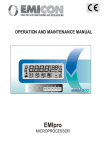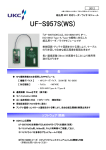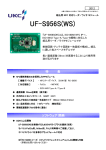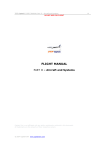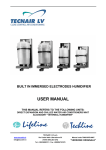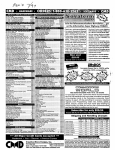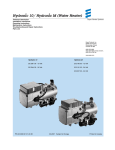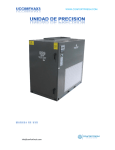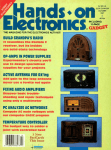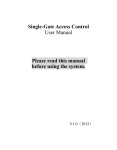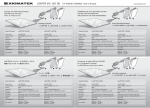Download Manuale d`uso User manual
Transcript
µAC Controllore per armadi di condizionamento µAC Electronic control for air-conditioning units LEGGI E CONSERVA QUESTE ISTRUZIONI READ AND SAVE THESE INSTRUCTIONS Manuale d’uso User manual Tecnologia ed Evoluzione 1. GENERAL CHARACTERISTICS 2 1.1 GENERAL DESCRIPTION MAIN FUNCTIONS: CONTROLLED DEVICES: OPTIONS: 2 2 2 2 2. EMIPRO USER INTERFACE 2 2.1 THE DISPLAY 2.2 STATUS INDICATORS MEANING OF THE LED (FIG. 3) 2.3 THE KEYPAD 3 5 5 5 3. PROGRAMMING PARAMETERS AND THEIR MODIFICATION 6 3.1 PARAMETERS 3.2 PARAMETER MODIFICATION ACCESSING DIRECT PARAMETERS (D) ACCESSING USER PARAMETERS (U) 6 6 6 7 4. DESCRIPTION AND CONFIGURATION OF THE PARAMETERS 8 5. CLOCK, TIME BANDS AND ALARM LOG 13 5.1 CLOCK TIME DISPLAY SETTING THE TIME 5.2 TIME BANDS COPYING THE TIME BANDS 5.3 ALARM LOG DISPLAY ALARM LOG DELETING THE ALARM LOG EXITING THE ALARM LOG 13 13 13 13 13 14 14 14 15 6. ALARMS AND SIGNALS 15 6.1 TABLE OF ALARM 6.2 ALARM DESCRIPTION 6.3 ALARM SIGNALS 6.4 MACHINE SHUT-DOWN SIGNALS 16 17 17 19 1 1. General characteristics 1.1 General description The EMIPRO is an electronic control for the complete management of precision air-conditioners, both in direct expansion versions (with 1 or 2 compressors), with 1 or 2 heating elements or with batteries (valve on the heating battery and/or valve on the cooling battery). The control also allows the management of a humidifier and dehumidification with various pre-settable configurations. Main functions: • Control based on the temperature and humidity of the inlet air • Energy saving with free-cooling (Shelters) or compensation • Dehumidification management • Control of the supply fan speed • Complete alarm management with log • Rotation of a series of units • Time bands • Can be connected to a serial line for supervisor / telemaintenance Controlled devices: • 1 or 2 compressors or valve for cooling battery • 1 or 2 heating elements or valve for heating battery • Supply fan in ON-OFF or proportional mode • Humidifier with proportional or ON-OFF output • Dehumidification with ON-OFF output • Alarm device Options: • RS485 serial board • Clock board with memory for logging the alarms and time bands • Fan control modules • Programming key 2. EMIPRO user interface The EMIPRO is made up of a display and a power board, see Fig. 1. 2 2.1 The display N.B. Fig. 2 illustrates all the symbols on starting the regulator. and the messages shown on the display; this occurs 3 4 2.2 Status indicators The main states of the regulator are displayed to the user through 3 LEDs on the front panel. Meaning of the LED (Fig. 3) Line LED (yellow): control powered Alarm LED (red): machine alarm (the siren symbol on the display is on only when the buzzer is active) ON LED (green): machine ON from keypad or supervisor (referred to the EEPROM variable). The effective ON status of the machine may, in addition, depend on the ON-OFF digital input, on the active time band, the stand-by condition transmitted from the master unit (if a series of units is in rotation), and is indicated by the illumination of the fan symbol. The ON-OFF symbols on the Display are illuminated only when the input of the remote contact is enabled and indicate the status of such contact. 2.3 The keypad The buttons have the following meanings: - Commutes status: if the machine is Standby; vice-versa, it is re-enabled. on, one press of the button places it in - Pressed for 5 secs accesses the User parameters. - In the presence of an alarm silences the buzzer. - Repeated pressing displays, cyclically: the current time, date and the temperature of the air in the room. - In programming phase scrolls or increases the value of the parameters. 5 - Held pressed displays the set-point. - In programming phase scrolls or decreases the value of the parameters. - Pressed for 5 secs accesses the Direct parameters. - In programming phase modifies the value of the selected parameter (see par. 5.2 - Parameter modification) - Pressed together for 2 secs reset the alarms. 3. Programming parameters and their modification 3.1 Parameters The parameters are divided into 3 levels, each of which contains access to customise the operation of the EMIPRO. the previous, which the user can 3.2 Parameter modification Accessing Direct parameters (D) The value of the first accessible parameter is displayed in the upper right, with the parameter code flashing. 6 Accessing User parameters (U) The number 0 is displayed and, on the left the lock symbol procedure. - The the , confirming access via password to the buttons are used to enter the password 22 (default), which is confirmed by pressing button. The value of the first accessible parameter is then displayed in the upper right, with the parameter code flashing. The value of the first accessible parameter is then displayed in the upper right, with the parameter code flashing. The buttons can be used to scroll the various parameters. Once having entered any level of parameters, one pressing of the flashing, of the parameter selected, while the Press button displays the value, buttons can be used to modify such value. again to temporarily store the new value. 7 Then, using the buttons, scroll the parameters menu, repeating the previous steps for each parameter to be modified. Press the button, on the other hand, to store the modifications made. During all phases of setting the parameters the open book symbol the display; on the other hand, when setting the password, a lock presence of a "block". is displayed in the lower left of also appears, confirming the 4. Description and configuration of the parameters / Probes Type 0123 Min. Max. U.o.M. Def. 1 Presence external air probe 0 = absent 1 = NTC Carel FFUU 0 1 Flag 0 2 Type of humidity/press./temp. probe B3 0 = absent 1 = 0-1Vdc or 0-20mA 2 = 4-20mA FFFF 0 2 Flags 0 3 Presence supply air B4 0 = absent 1 = NTC Carel (enable corresp. alarm) FFFF 0 1 Flag 0 4 Value of humidity/pressure at 0 mA, 4mA or 0Vdc FFFF 0 /5 %rH bar 0 5 Value of humidity/pressure at 20mA 0r 1Vdc FFFF /4 100 %rH bar 100 6 Calibration probe B1 UFUU -6.0 -10.8 6.0 10.8 °C °F 0.0 7 Calibration probe B2 UFUU -6.0 -10.8 6.0 10.8 °C °F 0.0 8 Calibration probe B3 UFUU -10.0 10.0 %rH bar 0.0 9 Calibration probe B4 UFUU -6.0 -10.8 6.0 10.8 °C °F 0.0 A Digital filter UFUU 1 15 - 4 b Input limit UFUU 1 15 - 8 c Unit of measure (0=°C,1=°F) UUUU 0 1 Flag 0 New 8 / Probes Type 0123 1 Temperature Set Point (cooling) DDDD 2 Cooling differential DDDD 3 Heating differential DDDD 4 Temperature dead zone 5 6 7 Min. Max. U.o.M. Def. rA rb °C/°F 20.0 0.1 0.1 11.0 19.8 °C °F 3.0 0.1 0.1 11.0 19.8 °C °F 2.0 DDDD 0.1 0.1 11.0 19.8 °C °F 1.0 Humidity Set Point DDDD rc rd %rH 50 Humidification differential DDDD 1 20 %rH 4 Dehumidification differential DDDD 1 20 %rH 3 8 Humidity dead zone DDDD 0 20 %rH 9 Temperature Set Point (heating) DDDD rA rb °C/°F 18.0 A Minimum temperature set point (also for U F U U compensation) -20 -4 rb °C °F 0 b Maximum temperature set point (also for compensation) UFUU rA 60 140 °C °F 50 c Minimum humidity set point UFUU 0 rd %rH 0 d Maximum humidity set point UFUU rc 100 %rH 100 E Type of temperature regulation 0=P, 1=PI UFUU 0 1 Flag 0 F Integration time for PI action UFUU 10 3600 s 600 for U F U U -2.0 2.0 H Set Point compensation on temp. read by B2 U F U U (cooling) -20 -4 60 140 °C °F 25.0 i Set Point compensation on temp. read by B2 U F U U (heating) -20 -4 60 140 °C °F 10.0 L Free cooling differential 0 0 30 54 °C °F 9 n Lower supply temperature limit during free U F U U cooling -20 -4 30 86 °C °F 5 o Reading from probe B2 DDDD °C/°F P Reading from probe B3 DDDD %rH/bar G Authority (unique compensation for Cooling/heating) UFUU r Reading from probe B4 DDDD t Time band setting 0 = disabled 1 = fan on minimum with temp. monitoring 2 = On/off UUDD New 0.5 °C/°F 0 2 Flags 0 9 c Compressor Type Min Max U.o.M. Def New 0123 1 Minimum ON time UFFF 0 300 s 60 2 Minimum OFF time UFFF 0 900 s 60 3 Time between 2 start-ups UFFF 0 900 s 360 4 ON delay between the 2 compressors UFFF 0 300 s 30 5 OFF delay between the 2 compressors UFFF 0 300 s 0 6 Compressor rotation 0 = disabled 1 = enabled FFFF 0 1 flag 0 7 Delay comp. ON from supply fan start-up UFUF 0 300 s 20 8 Hour counter threshold for the compressor 0= disabled UUUU 0 30000 h 0 9 Hour counter compressor 1 DUDU 0 30000 h 0 A Hour counter compressor 2 DUDU 0 30000 h 0 F Fans Type 0123 Min Max U.o.M. Def New 1 Fan operating mode 0 = always ON 1 = proportional speed regulation. If used in condensation the fan is kept at minimum even below the value of F5 2 = proportional speed regulation. If used in condensation the fan is switched off below the value of F5, with an hysteresis of 0.5 bar for pressure or 1°C for temperature FFFF 0 2 2 Minimum Triac voltage threshold FFFF 0 F4 step 35 3 Maximum Triac voltage threshold FFFF F3 100 step 75 4 Triac pulse width FFFF 0 15 ms 2 5 % regulation band for minimum speed or temperature/pressure /4 bar for minimum speed in condensation UFUF 0 0 /4 F6 % °C/°F bar 0.1 6 % regulation band for maximum speed or temperature/pressure /5 bar for maximum speed in condensation UFUF F5 100 158 /5 % °C/°F bar 100 7 Minimum output value UFUF 0 F8 % 10 flags 1 8 Maximum output value UFUF F7 100 % 100 9 Fan hour counter threshold 0 = disabled UUUU 0 30000 h 0 A Supply fan hour counter DUDU 0 30000 h 0 b Filter hour counter threshold 0 = disabled UUUU 0 30000 h 0 c Filter hour counter DUDU 0 30000 h 0 d Supply fan OFF delay UFUF 0 900 s 20 E Fan pick-up time in condensation UFFF 0 60 s 4 10 P Alarm Type 0123 Min Max U.M. Def 1 Flow alarm delay from fan start-up UFFF 0 250 s 20 2 Flow alarm delay during operation UFFF 0 90 s 5 3 Low pressure alarm delay from compressor ON UFFF 0 250 s 40 4 Buzzer activation 0 = OFF, 1-14= min. 15= continuous UUUU 0 15 min 0 5 Reset alarms (various configurations) FFFF 1 5 flag 1 6 Delta from effective set point for low temperature alarm UFUU 0 50 90 °C °F 10 7 Delta from effective set point for high temperature alarm UFUU 0 50 90 °F °C 10 8 Delta from set point for low humidity alarm UFUU 0 50 %rH 20 9 Delta from set point for high humidity alarm UFUU 0 50 %rH 20 A Alarm delay high/low temperature/humidity on start-up UUUU 0 150 min 20 b Type of management of generic alarm input ID5 0 = no alarm connected 1 = signal only alarm - automatic reset 2 = signal only alarm - manual reset 3 = serious alarm - automatic reset 4 = serious alarm - manual reset 5 = serious alarm - automatic reset also active in stand-by 6 = serious alarm - manual reset also active in stand-by UFUF 0 6 flag 1 c Generic alarm delay UUUF 0 250 s 60 d Return-supply temp. difference for supply temp. alarm UFFF 0 20 36 °C °F 3 Type 0123 Min Max U.M. Def H General HL= 1 Machine model 0 = ED unit 1 = CW unit 2 = CW unit (H/C) 3 = shelter FFFF 0 3 flags 0 2 No. of machines in rotation 0 = stand-alone machine 1 = 1 unit (master) 2 = 2 units.......6= 6 units UUUU 0 6 flags 0 3 Address of unit in rotation UUUU 1 6 - 1 4 Rotation time between a series of units 0 = test mode t=2 min. UUUU 0 250 h 0 5 Operating mode of the 2 “cool” outputs 1 = 1 compressor 2 = compressors on 2 circuits 3 = three-point valve 4 = 2 compressors in binary parallel 5 = 2 compressors in tandem (50+50%) FFFF 1 5 flags 1 New New 11 0 4 flags 1 FFFF 0 FFFF 0 600 s 150 1 flag 0 FFFF 0 9 flags 0 Function of the dehumidification/humidification relay 0= energised in dehumidification 1 = de-energised in dehumidification 2 = relay for non-serious alarms (follows logic of parameter HF) 3 = output for rotation control 4 = energised in humidification 5 = de-energised in humidification FFFF 0 5 flags 0 B Function of output Y2 (phase-cut) 0 = supply fan speed control 1 = condensation fan speed control using B3 2 = condensation fan speed control using B2 FFFF 0 2 flags 0 c Function of probe B2 0 = compensation 1 = free-cooling using 0-10V 2 = free-cooling using Out3-Out4 3 = free-cooling ON/OFF with Out3 4 = condensation control FFFF 0 3 flag 0 d Function of probe B3 0 = humidity control 1 = condensation control FFFF 0 1 flag 0 E ON/OFF digital input 0 = absent 1 = present UUUU 0 1 flag 0 F Alarm relay logic 0 = de-energised in alarm for all alarms 1 = energised in alarm for all alarms 2 = de-energised in alarm only for serious alarms 3 = energised in alarm only for serious alarms UUUF 0 3 flags 0 G Delay on start-up UUUU 0 300 s 0 H USER password UUUU 0 200 - 22 i Block parameter modifications (displayed by lock) 0 = no block UUUU 0 1 flag 0 L Parameter sets FFFF 0 3 flags 0 n Select data shown on display 0= probes B1, B3 (if present) 1= temperature. and humid. set-point (if present) 2= day and time (if clock present) UFUF 0 2 flags 0 6 Operating mode of the 2 “heat” outputs 0 = no heating element 1 = 1 heating element 2 = 2 heating elements 3 = three-point valve 4 = 2 heating elements in binary 7 3P valve or damper excursion time 8 Presence of humidifier 9 Type of dehumidification 0 = comp. 1 ON 1 = comp. 2 ON 2 = two comp. ON 3 = capacity-controlled cooling ramp 4 = fan speed reduction 5 = action 4+0 6 = action 4+1 7 = action 4+2 8 = action 4+3 9 = no action A FFFF 12 o Supervisor network serial address UUUU 1 200 - 1 P Supervisor serial baudrate 1= 1200, 2= 2400, 3= 4800, 4= 9600, 5=19200 Baud UUUU 1 5 flags 5 r Software version DDDD 1.1 5. Clock, time bands and alarm log Functions enabled only with the clock board memory installed. 5.1 Clock Time display Pressing the button displays the current time and date. Pressing the button once displays the time and the day of the week (1= Monday, 2= Tuesday, ..., 7= Sunday); pressing it again displays the date in the format day-month-year. Setting the time First press the button (keeping it pressed) and then the Prg button, keeping both pressed for 5 seconds. The minutes will begin to flash; use the buttons to set the desired time. Use the Sel button, on the other hand, to select, in order, the fields: hours - day of the week - year - month - day of the month. At the end, press the Prg button to confirm the modifications made. 5.2 Time bands Entering the parameter rt (see USER parameter modification) allows the selection of rt= 1 or 2, enabling the time band function. Pressing the Sel button displays, in sequence, with the scrolling of a segment, time bands 1, 2, 3, 4 of day 1 (Monday), ............ , time bands 1, 2, 3, 4 of day 7 (Sunday). The buttons allow, with 10 minute steps, the start time of the selected band to be modified, while the ON/OFF button enables or disables the action of the band itself, confirmed by the messages ON/OFF on the display. Copying the time bands If the times set for the bands are also valid for the following days, these can be simply copied by pressing and holding the Sel button for 3 seconds. Once the copy has been made, the following day is automatically displayed: if this too is to be copied, release the Sel button and then press it again for a further 3 seconds. The operating mode controlled by the time bands is indicated by the symbol on the display. 13 N.B. The ON status controlled by the time bands is only valid if the machine is first activated from the keypad or the remote input (if enabled). The OFF status controlled by the time bands, displayed by the “half moon” symbol on the display, acts according to whether parameter rt is set to 1 or 2: rt= 1, Sleep mode: during the OFF status, the fan, works and the actuators remain off. The machine is reactivated in the following conditions: a) the temperature exceeds 70% of the high/low alarm threshold, returning to Sleep if the temperature falls within 40% of the alarm delta. b) the ON/OFF is pressed: in this case the on status lasts until the next time band; during this period the symbol “A” flashes. rt= 2: the machine is in stand-by, as if the ON/OFF had been pressed. In this case too, pressing the ON/OFF button activates the machine until the next band switching OFF time. 5.3 Alarm log In the event of an alarm the alarm code, hour, minute and data are recorded, up to a maximum of 300 signals. On reaching the maximum number the oldest events are deleted (code 1 always indicates the most recent alarm). Display alarm log To display the list of alarms recorded, press the button, followed by the Alarm button. The code of the last alarm event is shown, and, on repeatedly pressing Sel, the hour, minute and the date. The buttons scroll the alarm data. In places where no alarm has been recorded, dashes are displayed in the place of the code. The display includes an incremental index in the right-hand field, which identifies the current position; the hundreds then appear in the field on the left (e.g.: “1 rES 55” indicates that a reset of the machine was performed, and the position is 155). Deleting the alarm log The entire alarm log can be deleted from within the display of log itself, by pressing the buttons together for 5 seconds. At this point the FACTORY password (177) is required, which, confirmed by enter, leads to the deletion of the log. 14 This operation re-initialises the clock board EEPROM and must be performed when installing the board itself. The alarm codes displayed are those reported in the table in the chap-ter on the alarms; in addition, other special codes have been included to signal the following events: Exiting the alarm log To exit the alarm log menu, press the Alarm button. The menu is exited in any case by time-out, after 60 seconds. 6. Alarms and signals In the event of an alarm, the machine performs the following actions: • activates the buzzer and display , (if enabled and machine ON); • activates the alarm relay (according to parameters HF, HA); • displays the alarm code and switches on the corresponding red LED. In this condition, pressing the alarm button silences the buzzer. The termination of alarms with automatic reset, if no alarms with manual reset are active, brings about: • the switching off of the buzzer; • the deactivation of the alarm relay, see parameter HF; • the switching off of the red alarm LED; • the re-activation of the actuators switched off by the alarm. Pressing the buttons together for 2 seconds cancels the display of the alarm codes. In the event of alarms with manual reset, pressing the buttons together for 2 seconds brings about: • the deactivation of the alarm relay, see parameter HF; • the switching off of the red alarm LED; • the re-activation of the actuators switched off by the alarm. The maintenance signals for compressors 1 and/or 2, the fan and the filter, due to the exceeding of the hour counter thresholds, activate the symbol on the display, the red LED, the buzzer and the alarm relay. The alarm messages are shown cyclically in the order indicated in the following table. On termination, the display of the percentage of humidity (if present) returns for 6 seconds. 15 6.1 Table of alarm n. Cod. Description Delay Reset Buzz. Alarm C1 C2 R1 R2 Sys/ON Fan Hum. Dehum 1 E1 probe B1 1 min P5 ON ON - - OFF OFF 2 E2 probe B2 1 min P5 ON ON - - - 3 E3 probe B3 1 min P5 ON ON - - - - - - - - - - - OFF OFF 4 E4 probe B4 1 min P5 ON ON - - - - - - - - 5 Er: E EEPROM boot imm. auto - - OFF OFF OFF OFF 6 EE EEPROM run imm. auto ON ON - - - - - - - - 7 EL insuff. power imm. auto ON ON - - - - - - - - 8 H1 high press C1 imm. man ON ON OFF - - - - - - - 9 H2 high press C2 imm. man ON ON - OFF - - - - - - 10 L1 low press C1 P3 P5 ON ON OFF - - - - - - - 11 L2 low press C2 P3 P5 ON ON - OFF - - - - - - 12 F1 filter dirty imm. P5 ON ON - - - - - - - - 13 FL flow P1/2 P5 ON ON OFF OFF OFF OFF OFF OFF OFF OFF OFF OFF OFF OFF OFF OFF OFF OFF 14 r1 heating elements Imm. man ON ON 15 At supply temp 2min P5 ON ON - 16 AH humidifier 30 s P5 ON ON - 17 Lt low temp. PA P5 ON ON - - - - - - - - - - - - - - - - OFF - - - - - - - - - OFF OFF OFF OFF 18 Ht high temp. PA P5 ON ON ON ON - - - - - - 19 LH low humid. PA P5 ON ON - - - - - - - - 20 HH high humid. PA P5 ON ON - - - - - - - - 21 tC comp. thermal imm. P5 ON ON OFF - - - - - - - 22 Tf fan thermal imm. P5 ON ON OFF OFF OFF OFF OFF OFF OFF OFF 23 AL serious generic PC Pb ON ON OFF OFF OFF OFF OFF OFF OFF OFF 24 PA power fail 2s auto ON ON OFF - OFF - - - - - 25 CL clock imm. man ON ON - - - - - - - - 26 n1 + hour counter threshold compressor 1 imm. c9 ON ON - - - - - - - - 27 n2 + hour counter threshold compressor 2 imm. cA ON ON - - - - - - - - 28 nf + hour counter threshold filter imm. FC ON ON - - - - - - - - 29 nn + hour counter threshold fan imm. FA ON ON - - - - - - - - 16 6.2 Alarm Description Cod. Description P5= 1 P5= 2 P5= 3 P5= 4 P5= 5 E1 probe B1 auto auto man auto auto E2 probe B2 auto auto man auto auto E3 probe B3 auto auto man auto auto E4 probe B4 auto auto man auto auto EE eeprom run man man man man man EL insuff. power on EEPROM write man man man man man H1 high pressure C1 man man man man man H2 high pressure C2 man man man man man L1 low pressure C1 man auto man auto auto L2 low pressure C2 man auto man auto auto F1 filter dirty man auto man man auto FL flow man auto man man man r1 heating elements man man man man man At supply temp man auto man man man AH humidifier man auto man auto auto Lt low temperature man auto man auto auto Ht high temperature man auto man auto auto LH low humidity man auto man auto auto HH high humidity man auto man auto auto tC comp. thermal man auto man man auto tF fan thermal man auto man man auto AL serious generic Pb Pb Pb Pb Pb PA power fail (shelters) auto auto auto auto auto CL clock man man man man man 6.3 Alarm signals All the alarms, except for the generic external alarm (AL), configured by parameter Pb, and the clock, are detected only when the machine is ON. E1: ambient temperature probe failure: generated due to open or short-circuited probe. Alarm delayed by 1 minute from the instant the machine is placed ON and when the error is detected. At the moment of detection the control is placed OFF, respecting the configured times, except for the fan. E2: external air probe failure: generated due to open or short-circuited probe. Alarm delayed by 1 minute from the instant the machine is placed ON and when the error is detected. At the moment of detection the corresponding functions -compensation and free cooling are deactivated. If probe B2 is used for condensation, the fan is forced on at maximum speed. E3: humidity / pressure probe failure: generated due to open probe and for voltages above 1.15V, if the input is configured as 0÷1V, or, if the input is configured as 4÷20mA, for currents below 3mA and over 23mA. Alarm delayed by 1 minute from the instant the machine is placed ON and when the error is detected. At the moment of detection the corresponding functions are deactivated: - humidity control (humidification, dehumidification); - if probe B3 is used as a pressure sensor, for the control of condensation, and probe B2 is present for reading the external air temperature, the fan is forced on at maximum speed if the temperature measured by B2>15°C. The same is true if probe B2 is not present. - If the temperature B2² 15°C, on the other hand, the fan operates at half speed. 17 E4: supply air temperature probe: generated due to open or short-circuited probe. Alarm delayed by 1 minute from the instant the machine is placed ON and when the error is detected. At the moment of detection the corresponding functions are deactivated: supply temperature alarm management (At), and, if free-cooling is active with control of the supply temperature, the damper is closed. EE: EEPROM data read/write error. Can occur also during a reset only if it is not possible to make the correction to the secondary bank. This error does not affect the operation of the regulator. EL: insufficient power supply during EEPROM write Data write error to EEPROM due to power failure or power below 13Veff. H1-H2: high pressure C1-C2 Detected irrespective of the activation of the compressor, and causes its immediate switching off without waiting the corresponding delay times. The alarm H2 is managed only if parameter H5= 2 or 4 (two independent circuits). If condensation fan regulation is present, this is activated for 60 seconds at maximum speed before switching off. L1-L2: low pressure C1-C2 Detected only with the compressor on, and causes its immediate switching off without waiting the corresponding delay times. The alarm is delayed by P3 seconds on the start-up of the compressor. If automatic reset is set, parameter P5, a compressor restart is attempted 10 times, then the alarm is automatic reset automatically. The alarm L2 is managed only if parameter H5= 2 or 4 (two independent circuits). F1: dirty filter Signal-only alarm. No outputs are deactivated. FL: air flow alarm Alarm delayed by parameters P1 and P2. The activation of this alarm causes the switching off of all of devices without waiting the delay times of the compressors and the fan. If set for automatic reset, parameter P5, a restart of the outputs is attempted 10 times. r1: heating element thermal overload alarm Causes the immediate switching off of the heating elements. At: high supply temperature alarm (cooling function) Enabled by the presence of the supply air temperature probe B4 (parameter /2) and by the setting of parameter Pd. The alarm has a fixed delay of 2 minutes, and is activated only if the cooling actuators are on and heating actuators are off. In particular, the conditions leading to the activation of the alarm are: • ED: at least one compressor on and heating elements off or heating valve closed; • CW: cooling valve open more than 50% and heating valve closed or heating elements off. This alarm, when detected, only blocks the compressor on at that moment, while the second compressor remains enabled. AH: humidifier alarm Alarm delayed by 30 seconds. If detected, the humidifier output (0÷10Vdc or relay) is deactivated. Lt: low temperature alarm Ht: high temperature alarm These alarms are delayed on the start-up of the regulator (or on exiting stand-by mode) for a period equal to parameter PA, and for 1 minute on exceeding the set threshold. The reset occurs, if programmed as automatic, 1 degree above (Lt) and 1 degree below (Ht) the threshold. 18 In addition, exceeding the high temperature threshold causes the immediate start-up of the compressors without waiting the corresponding delay times. LH-HH: low-high humidity alarm These alarms are delayed on start-up (or on exiting stand-by mode) for a period equal to parameter PA, and for 1 minute from exceeding the set threshold. These are signal-only alarms, with an hysteresis of 1% R.H. tC: compressor thermal overload alarm Immediate alarm, causes the instant switching off of the compressor. This is managed only if parameter H5= 1 or 5 (one compressor only or two compressors in tandem). tF: fan thermal overload alarm Immediate alarm, causes the instant switching off of all devices without respecting the compressor delay times. This is managed only if parameter H5= 1 or 5 (one compressor only or two compressors in tandem). AL: generic external alarm This alarm can be configured by setting parameters Pb and PC. If configured as a serious alarm, it switches off all actuators without respecting the delay times. PA: shelter power failure alarm External power failure alarm delayed by 2 seconds. This is generated for models configured as shelters when input ID6 is open; it causes the immediate switching off of the compressor and the heating element. CL: clock failure alarm Alarm generated by the malfunctioning of the clock board. Interrupts the time band function, and the regulator goes into ON status if even the current band provides an off command. This event does not block the alarm log, which continues to store the signals, however with incorrect time values. n1: compressor 1 maintenance warning n2: compressor 2 maintenance warning Signal-only alarm generated when the hour counter threshold has been exceeded, displayed together with the symbol, see parameters c9 (compressor 1) and cA (compressor 2). nF: filter maintenance warning nU: fan maintenance warning n2: compressor 2 maintenance warning Signal-only alarm generated when the hour counter threshold has been exceeded, displayed together with the symbol, see parameters FC (filters) and FA (fan). 6.4 Machine shut-down signals These appear in the event of internal machine malfunctions and cause its shut-down. The code is displayed in the ambient temperature (or hour-minutes) field of the LCD display. Er: C Checksum error during code check in Flash: the control can no longer be used. Er: E The content of the EEPROM (parameter memory) is damaged. A reset can be attempted by reloading the default values. Er: L Insufficient power: Power voltage < 13Veff when writing the default values or during an attempt to automatically recovery an EEPROM damaged sector. 19




















